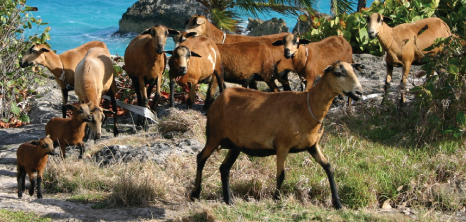|
Barbados Blackbelly SheepThis name is truly an apt description of what the Barbados Blackbelly Sheep look like, as they do have black bellies. This sheep is unique to the island of Barbados and can be seen grazing on just about any pasture on the island.
The Barbados Blackbelly Sheep, when cooked, is succulent and enjoyed by all people in Barbados. The demand for this sheep in Barbados is quite high and because the island is unable to meet the demands, this sheep is now commercially raised and imported from several tropical countries.
Characteristics of the Barbados Blackbelly SheepThe Barbados Blackbelly Sheep does not have wool but instead, is covered with coarse hair. Maybe this is the reason why they are able to withstand more heat than most breeds of sheep.
The colour ranges from light tan to reddish brown with its under belly and inside legs covered in black. In some instances, the tips of the tail can be white. When this occurence is present with no more than 2.5 to 5 cm of white on the tail, these sheep are accpeted by farmers and agriculturalists on the island for a pure bred Barbados Blackbelly Sheep.
The Barbados Blackbelly Sheep has large and pointed ears with the insides black. The eyes are brown in colour with nearby black stripes. A black mark runs from the base of the nose on each side to the crown of the head with black stripes on the face and black legs, belly, chin, and chest. The horn bases in mature rams are also black.
Generally, the Barbados Blackbelly Sheep has the appearance of a small deer or antelope.
History of the Barbados Blackbelly SheepThere have been suggestions that the Barbados Blackbelly Sheep was brought in from either Africa or Brazil. However, there has been no substantial evidence that has been consistent with any available historical or genetic evidence to support this claim as there has been failure to find this species of sheep anywhere else.
With regards to the Barbados Blackbelly, Ligon established in 1657 that the parent stocks necessary for the evolution of a highly prolific, tropically adapted breed had been established in Barbados in the first quarter-century of colonization.
Due to the strong Dutch trade at that time, evidence is presented that the wool sheep may have been a Dutch breed.
Whatever the origin of the Barbados Blackbelly Sheep, one thing is for sure and that is that they were able to become a very integral part of our agricultural industry and household tables.
Barbados Blackbelly Sheep AssociationThe Barbados Blackbelly Sheep Association (BBSAI) is the international registry for both Barbados Blackbelly sheep and American Blackbelly sheep. Their purpose is to
|



